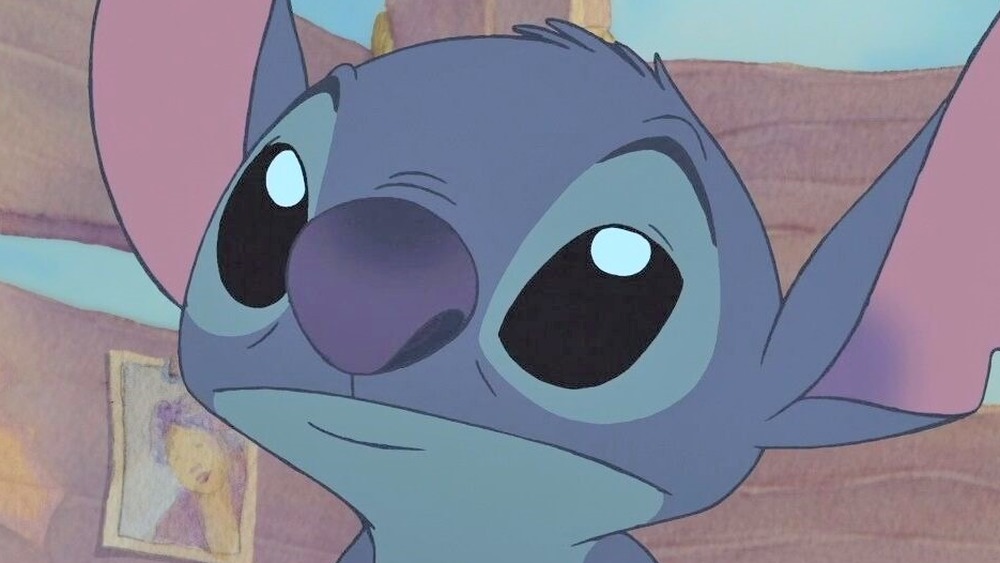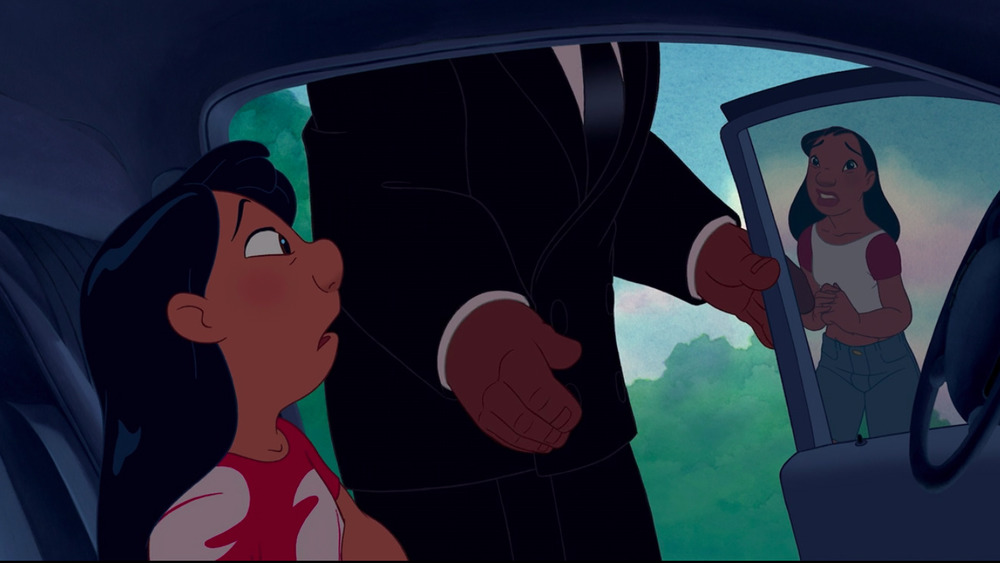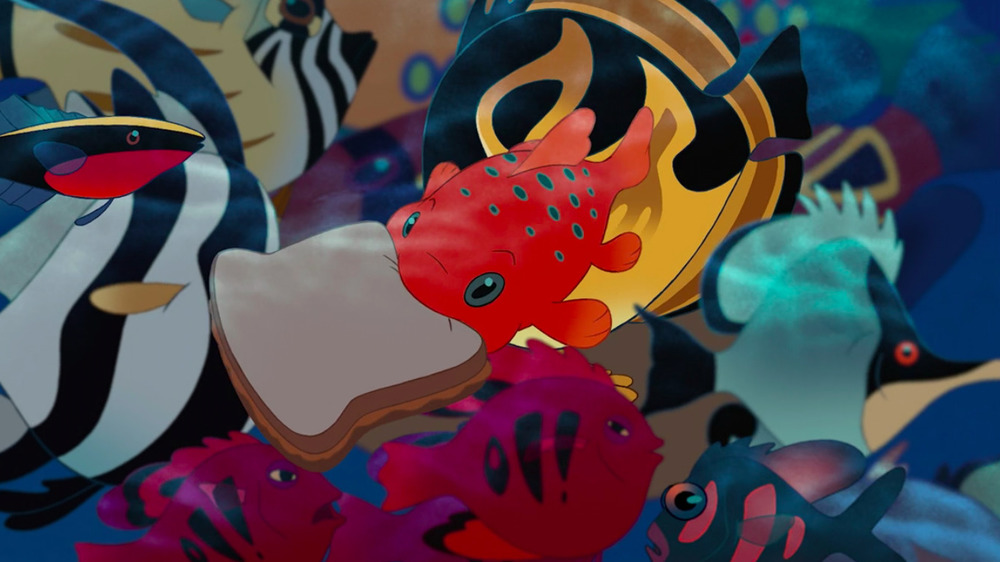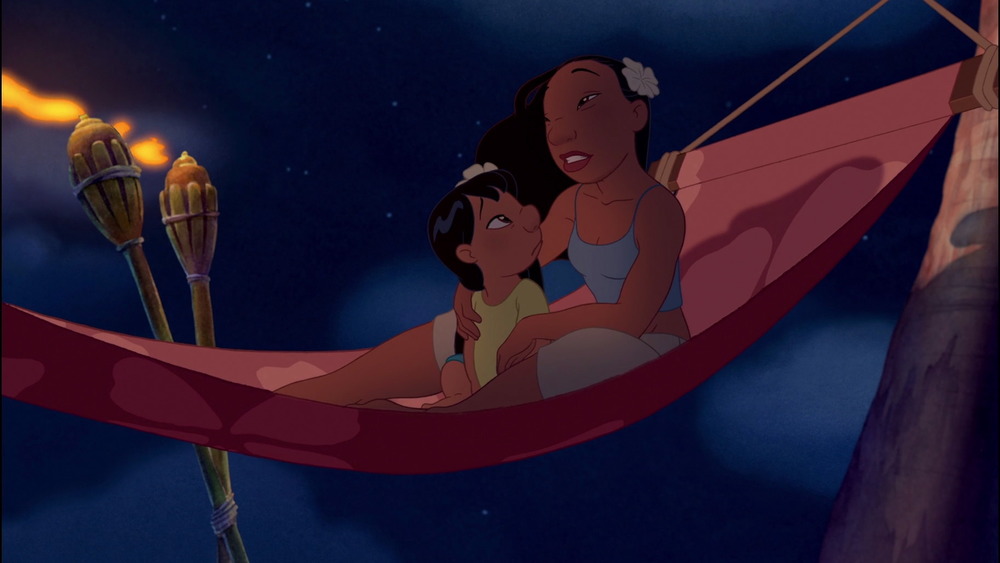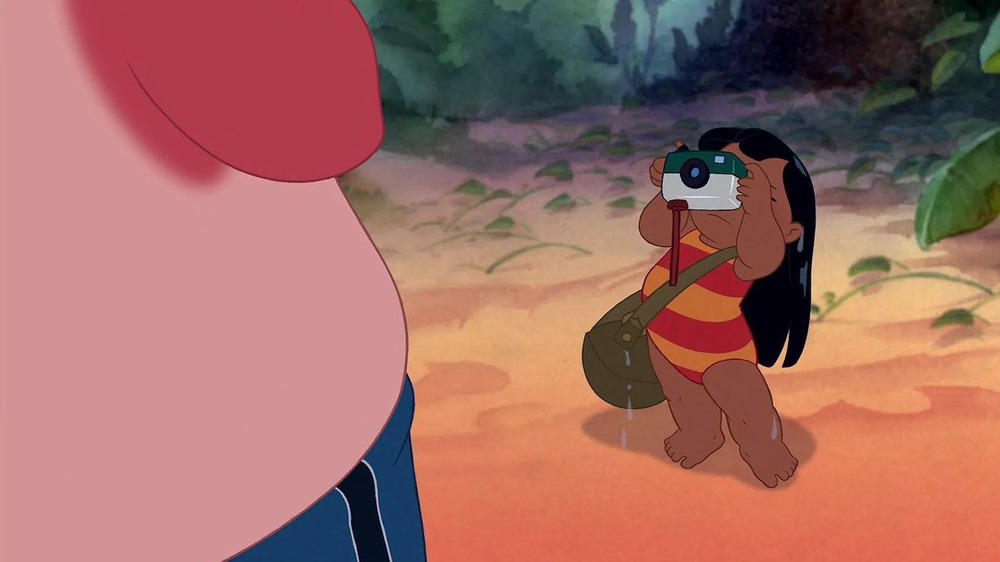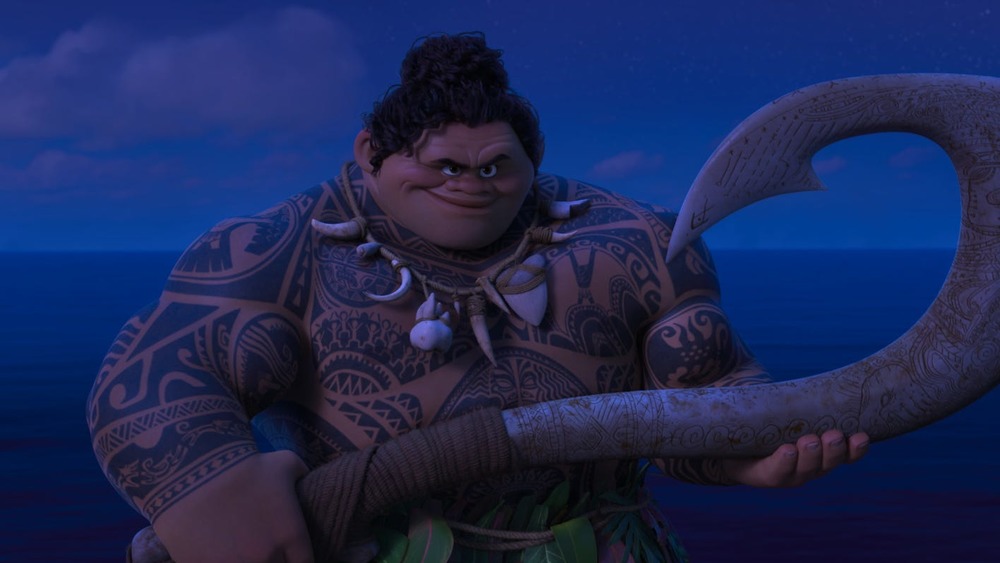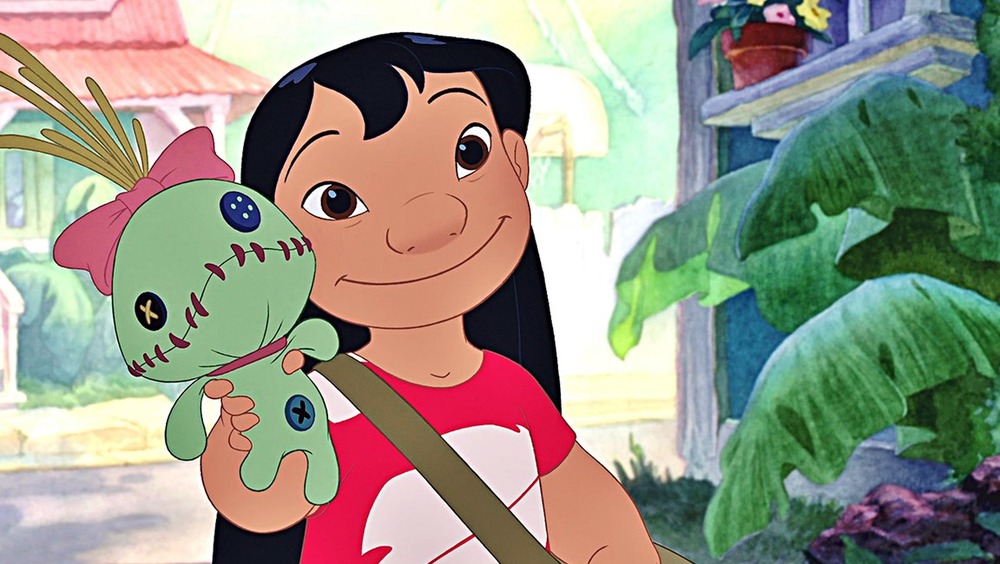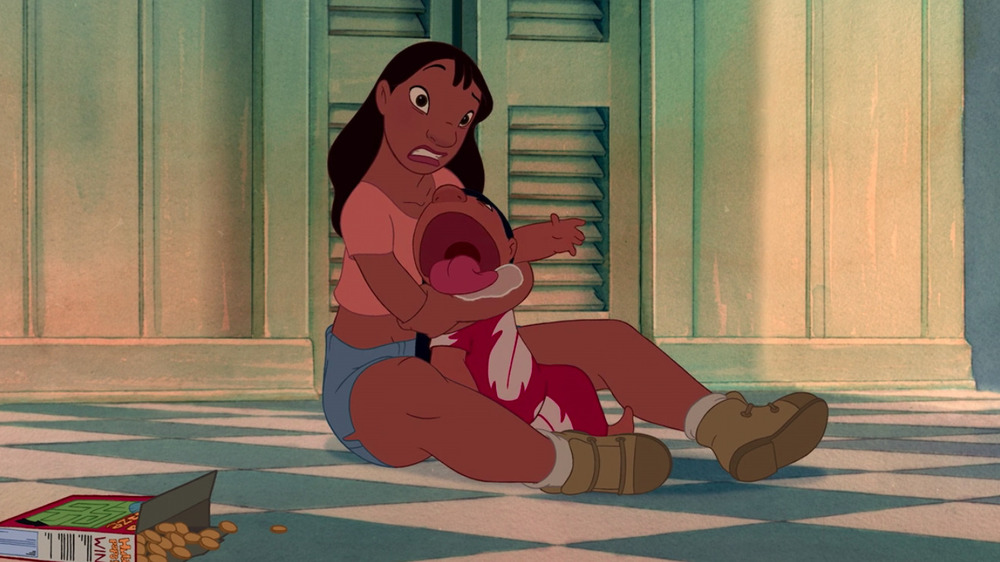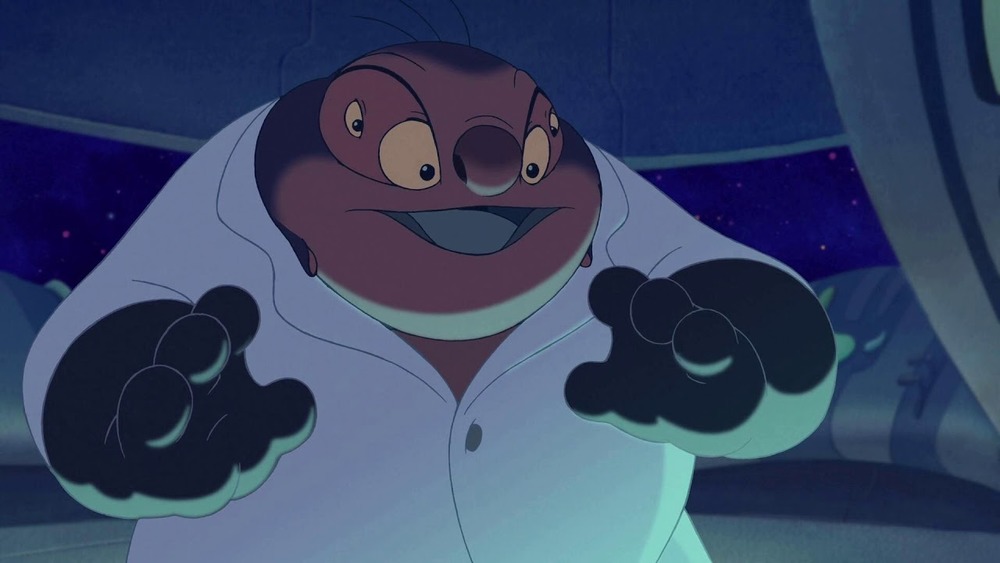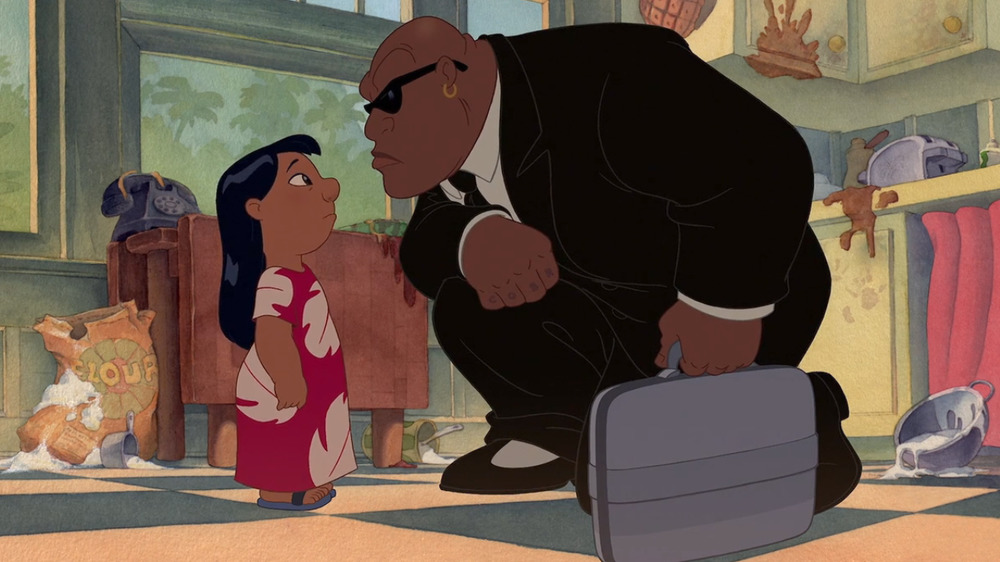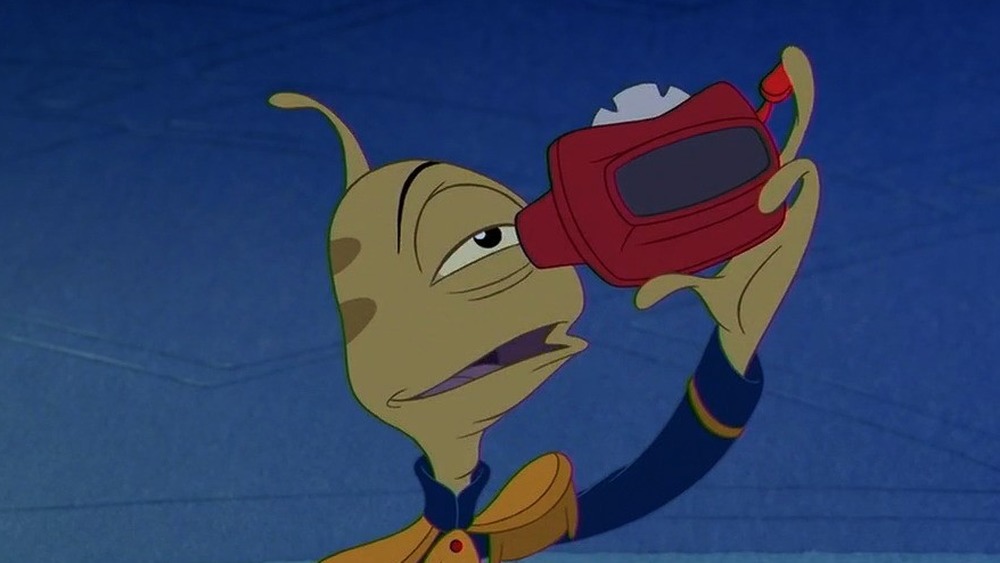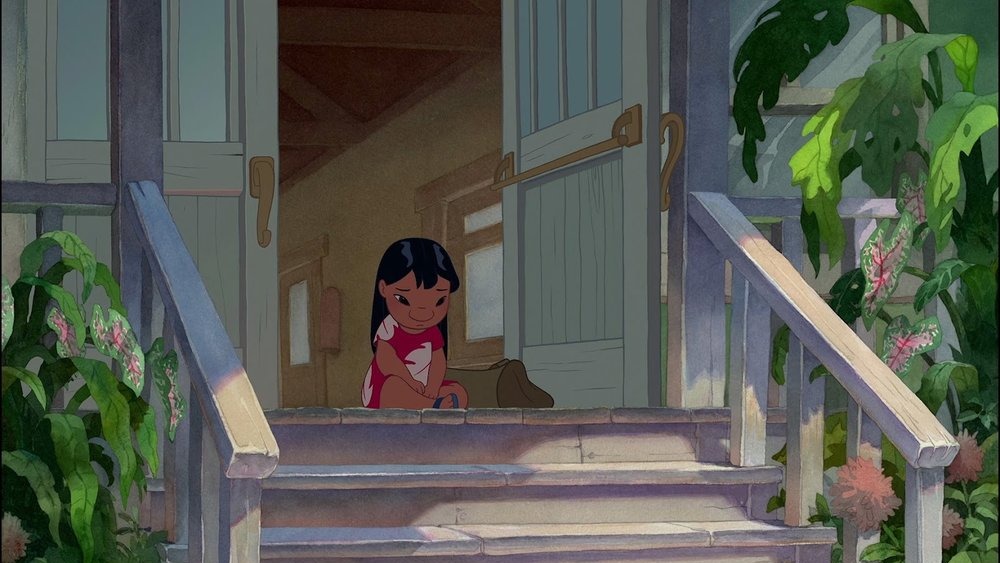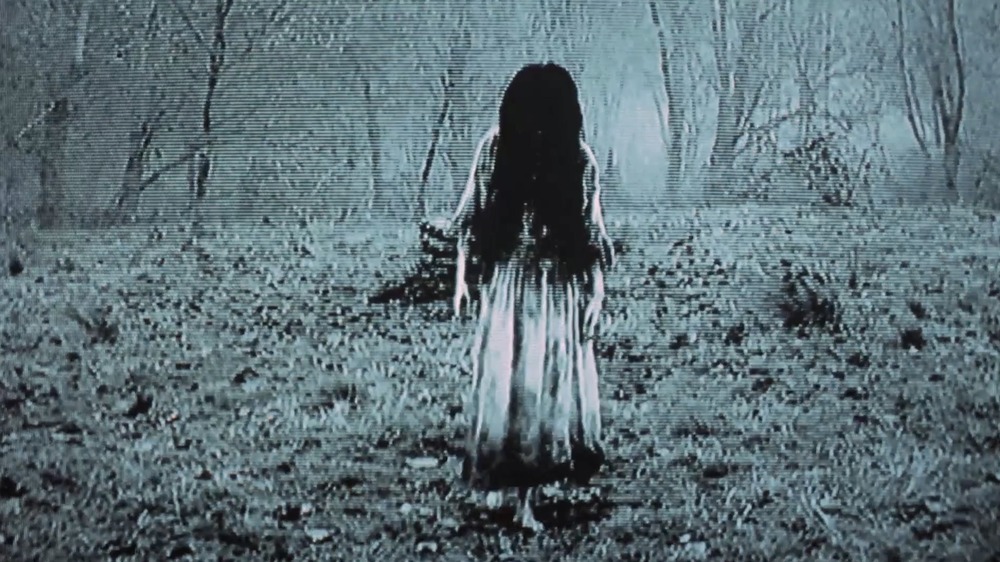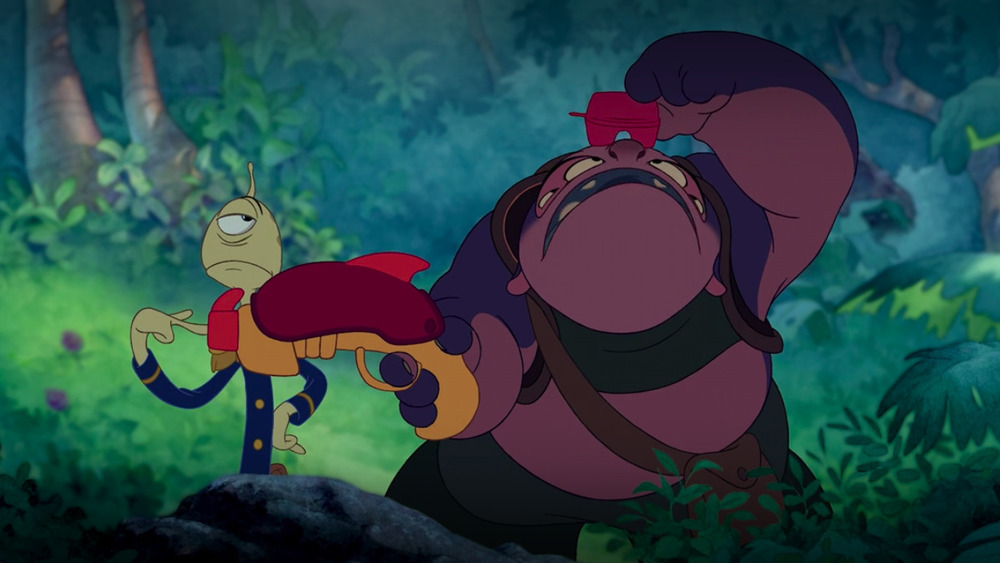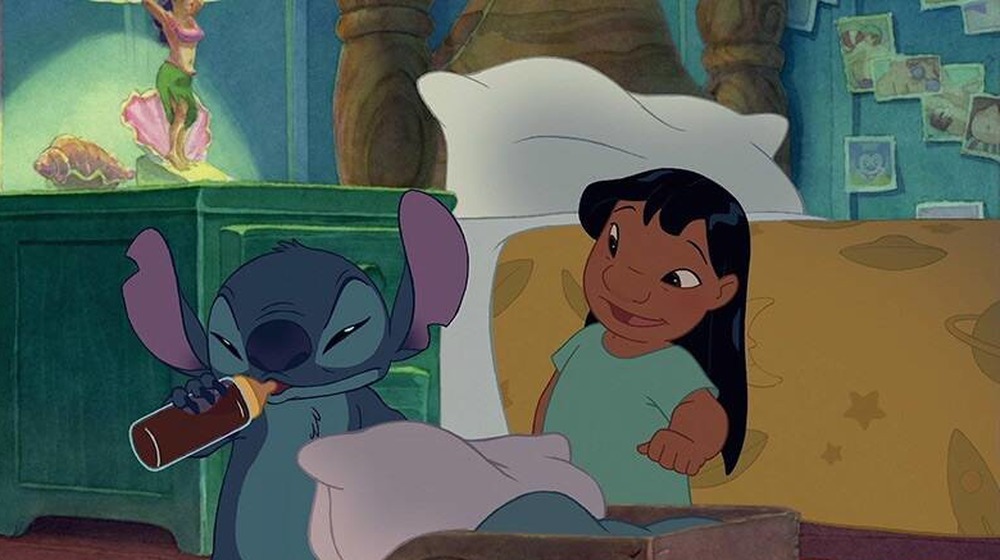Things Only Adults Notice In Lilo And Stitch
After it's world-conquering run in the '90s, Walt Disney Animation suffered a major downturn with a series of expensive flops like Treasure Planet, Atlantis: The Lost Empire, and Home on the Range that would kill hand-drawn animation at the studio for half a decade. But in between these epic disasters with epic ambitions, Disney pulled out one last hit with a small-scale story about a girl and her dog — or whatever Stitch is — and it's quite possibly the best movie they ever made.
Lilo and Stitch the story of a genetically engineered killing machine who escapes from custody on another planet and the little girl who adopts him. At least, that's what the story is on the surface. But Lilo and Stitch is one of Disney's finest moments because it's really two different movies. For kids, it's a slapsticky adventure full of wacky aliens. But watching it as an adult, a whole other picture becomes apparent — a much darker, sadder story about characters left adrift in the world, a story that makes its happy ending beautifully cathartic. And those are just some of the nuggets we found looking at Lilo and Stitch through adult eyes, along with plenty of background gags, cultural references, and other subtleties we missed the first time around.
Kids may miss just how dire Lilo and Nani's situation is
Lilo and her big sister, Nani, are in dire straits even before Stitch drops from the sky. They live alone — we later learn their parents recently died, but adults will probably have guessed that already — and Nani can barely keep food on the table. As a result, there's the looming threat the state will take Lilo away. And it only gets worse when Stitch gets Nani booted from her job and every interview she takes to find new work.
To kids, at least ones who haven't experienced it firsthand, this situation may not seem any darker than Cinderella's. But adults should recognize it's all too real. Lilo is full of weird, dark behavior, like making voodoo dolls of her classmates. But that's not just cartoon wackiness — this is a realistic little girl acting out deep, deep trauma.
But the genius of writer-directors Chris Sanders and Dean DeBlois is shielding children from these disturbing elements while still giving adults an emotionally satisfying story that respects their intelligence. They do this by keeping the subtext in subtle hints that kids may miss but will pierce adult hearts like little daggers. Just look at how after revealing what happened to her parents, Lilo asks Stitch, "What happened to yours? I hear you cry at night. Do you dream about them? I know that's why you wreck things and push me." She's obviously speaking from experience.
There's a deeper reason behind Lilo's sandwich ritual
We first see Lilo in all her weirdness when she arrives late for dance practice. She explains the reason for her tardiness at great length, saying that it's "Sandwich Day." In other words, she has to give Pudge the fish a sandwich, and since she was out of peanut butter, she had to run to the store and buy a new jar, all so the fish could get his treat. When the teacher tries to figure out why Pudge needs a sandwich, Lilo calms down enough to very matter-of-factly explain, "Pudge controls the weather."
It's a hilarious scene, but if you pay attention, it's also deeply sad. We later learn that Lilo's parents died by losing control of their car in a rainstorm. Their death obviously affected Lilo deeply, but a kid's mind doesn't react to trauma quite the same way as an adult's. Her sandwich ritual is apparently some kind of coping mechanism, trying to process her parents' weather-related tragedy by going to great lengths from keeping it from happening to anyone else.
Lilo's struggle mirrors Hawaii's
There's a political dimension to Lilo and Nani's troubles. Despite the cheerful, colorful exterior Hawaii puts on to draw in tourists, its history is anything but, especially since, at the turn of the century, the US government joined their business interests on the islands to overthrow Hawaii's last indigenous monarch, Liliʻuokalani. As film critic Lindsay Ellis notes, Lilo and Stitch's soundtrack recaps some of that history in the Hawaiian-language lyrics to both "Aloha Oe" (written by Liliʻuokalani herself) and the new composition "He Mele No Lilo." Sanders and DeBlois very pointedly use "Aloha Oe," a lament for Hawaii's lost independence, for the scene of Lilo and Nani saying goodbye before the US government splits them up, as it's done to so many indigenous families throughout its history.
Ironically, that song's been popular with the tourist industry, which Lilo and Stitch subtly skewers with Nani's waitress job, where she wears her heritage as a cheap, exaggerated costume for the benefit of outsiders who don't share it, and she tells her boss how she feels on her way out the door: "Who wants to work at this stupid, fakey luau anyway?" There's more social commentary in the job-hunting montage that follows, where nearly all the opportunities available to Nani at beaches and hotels are for the benefit of mainlanders.
Lilo turns the tables on the tourists
Lilo takes direct aim at the flood of outsiders coming into Hawaii with her camera, snapping photos of them, much to their confusion. As a native Hawaiian, she knows they see her as an exotic commodity, and adults who are aware of the state's difficult history should recognize Lilo's shutterbug hobby as her way of getting revenge. Critical theorists like to talk about "switching the lens" of how we look at the world. Well, here Lilo does just that by literally turning the lens in the opposite directions.
The implications of this little running gag are surprisingly radical for a company that, for all its strengths, has been notoriously timid in confronting race relations. That may be why one scene making the connection clearer didn't make it to theaters. In it, we get to see Lilo's relationship with tourists before she turns it on its head, with a white girl on the beach pointing at Lilo and cooing, "Oh look! A real native!" A minute later, Cobra catches Lilo engineering a stampede on the beach by convincing the crowd of tourists that the siren test is actually a tsunami warning. He doesn't look happy, but Lilo tells him, "If you lived here, you'd understand."
David's necklace references a Polynesian legend
The Disney crew obviously did their homework on Pacific Islander heritage, and some of it may have paid off years down the road. One of Nani's coworkers at her ill-fated luau job is David, a fire juggler who's interested in Nani. And in one scene, he's wearing a necklace with a stylized fish hook hanging from it.
It's not just for looks — it's an ancient symbol of Hawaiian heritage. That hook is called Manaiakalani, and it belongs to the legendary hero Maui. You may recognize both Maui and his hook from Disney's Moana. Maui's stories appear, with many variations, all across the Pacific. According to the version told in New Zealand, he made Manaiakalani out of the jawbone of his own grandmother, and other stories say it could magically catch anything and that Maui used it to fish Hawaii out of the ocean. David's necklace looks uncannily like the version of Manaiakalani that appears over a decade in Moana, where it has even more magical properties that allow Maui to change into any animal imaginable — or would if Moana hadn't broken it.
Scrump is a symptom of Nani's financial troubles
One of Lilo and Stitch's most iconic images is Scrump, the creepy little doll that Lilo made for herself. Lilo pulls out Scrump when she sees her classmates playing with their much prettier store-bought dolls. Kids might think Scrump is just another example of Lilo's weirdness, but adults can recognize a sadder truth behind the toy's existence. Lilo would probably be happy to play with a Barbie doll, but now that Nani has to support the family on her own, she can't afford one. As a result, Scrump is apparently made from scraps of old clothes, with mismatched buttons for eyes and straw for hair. You can read a lot more into the other girls' disgust with the ugly little thing than just its weirdness. We like to say kids are pure and innocent, but they learn class prejudice pretty early.
We know Lilo and Stitch are two of a kind before they even meet
The marketing for Lilo and Stitch emphasized Stitch's bad-boy attitude, with trailers set to AC/DC's "Back in Black" showing him invading past classics as if to say, "This ain't your daddy's Disney movie!" But in the movie itself, he's just as much a lost soul as Lilo, a monster built to destroy but unable to fulfill his purpose, a freak without a family. Adults should recognize the parallels between Lilo and Stitch's innocent but unstoppable destructiveness, and there are more concrete similarities that encourage attentive viewers to see Lilo and Stitch as two of a kind before they're even within lightyears of each other.
When Stitch bites big, tough Captain Gantu, the soldier takes a quiet moment to ask, "Does this look infected to you?" When Lilo bites another girl, her victim also worries it might be infected. Lilo gets out of Nani's grip by drooling on her with a big, floppy tongue that looks just like the one Stitch uses to vandalize his glass cage on the alien space station, and then she scurries away on all fours, just like her pet. Plus, Lilo says if she fed Pudge tuna she'd be an abomination — the exact word the Galactic Councilwoman uses to describe Stitch.
Jumba lied about never making more than one
We first see Stitch when Dr. Jumba Jookiba is on trial for creating him, fiercely denying he'd ever make such a monster before having to course-correct when the Galactic Council springs the evidence on him. "I would never, ever ... make more than one."
But then, immediately after that, he refers to Stitch as "Experiment 626." If he would never make more than one, what about the other 625? That would become the basis for the TV spinoff Lilo and Stitch: The Series, where Jumba's past experiments get loose in Hawaii. It didn't quite run for 625 episodes, but it did introduce a good number of new creatures, including the electrical Sparky, Nosox (a washing machine-shaped critter who makes socks disappear), and Angel (think Stitch if he was a girl). But if you pay attention during the movie, you probably don't need any TV show to confirm what you already know.
Lilo and Stitch is full of UFO lore
Lilo and Stitch isn't exactly hard sci-fi, but it does have plenty of inside jokes for fans of alien phenomena. Even though he's supposed to be a lowly CPS inspector, Cobra Bubbles dresses in a black suit and sunglasses like the mysterious Men in Black — creepy government agents who supposedly threaten UFO witnesses to keep quiet. With that in mind, it's barely a twist when Cobra reveals that he actually works for the CIA.
He also mentions he's met aliens before, at one of history's most famous UFO sites — Roswell, New Mexico. But if you think that means he's confirming the rumors, just know that he was there in 1973, over 25 years after the notorious UFO incident.
The opening scene puts an even twistier twist on UFO lore. Area 51, Nevada's highly secretive US Air Force base, is even more central to alien legends than Roswell, with rumors claiming it contains captive extraterrestrials, crashed spaceships, weather control experiments, a secret global government, and all kinds of other secrets. In Lilo and Stitch though, one quick line of dialogue on the alien space station reveals Area 51 is Earth itself, at least by the Galactic Council's reckoning.
Pleakley only sees half his View-Master reel
The Galactic Council is so terrified of Stitch's destructive capabilities that their first thought when he escapes to Earth is to obliterate the whole planet. Before they can, Agent Pleakley rushes in to remind them that they can't touch Earth because it's a wildlife refuge for mosquitoes. His "evidence" is a View-Master reel, and he continues consulting it after arriving in Hawaii.
There's a lot going on here that's easy to miss, especially for children. Kids nowadays probably wouldn't even know what a View-Master is, and it takes an adult knowledge of graphic design history to appreciate the hilariously cheesy '50s-style graphics Pleakley uses to make his case. But the funniest part of all is even subtler than that. The big draw of the View-Master is the way they used reels with duplicate images, one for each eye, to create a three-dimensional photo. But since Pleakley only has one eye, the whole effect would be lost on him. Then again, enough kids got bored waiting for the image to focus and just closed one eye that he's not alone.
Lilo and Stitch revived a lost animation art
If Lilo and Stitch is one of Disney's best features, it's largely thanks to the gorgeous visuals. Seriously, few Disney movies have looked this good since their initial run from the early Silly Symphonies shorts through Dumbo.
There's a surprisingly technical reason for that. For its first decade or two, Disney painted almost all their animated worlds and characters with watercolor before switching to more cost-effective but less expressive oils and acrylics in the '40s and '50s. By the time Lilo and Stitch went into production, most animators were leaving paint behind altogether, either augmenting the colors or creating them entirely on computers.
But the filmmakers insisted on reviving watercolor for Lilo and Stitch — even if it meant the artists had to relearn their art from scratch. But the effort paid off, allowing for the subtle blending of skin tones in the characters and the beautiful backgrounds, which can be romantically hazy or tangibly solid according to what the scene calls for.
Lilo shares a voice with a horror icon
Actress Daveigh Chase provides the voice of Lilo, and she perfectly captures the matter-of-fact lunacy of real kids and sells the big emotional moments with heartbreaking skill. But in 2002, audiences may have recognized Chase from a much more frightening role.
In Gore Verbinski's remake of the Japanese horror hit The Ring, Chase appears as Samara, the creepy little girl who haunts a mysterious videotape. Based on the original film's Sadako, Chase's character brought one of the most iconic images in horror to a new audience — stalking her victims in a white dress, with long, dark hair covering her face. Her eerie silence makes her even more menacing, but we do get to hear Samara's voice in a few flashbacks to her pre-ghost life, and she sounds an awful lot like Lilo.
Animation takes so long that it's hard to imagine Lilo and Stitch's creators could've known their lead voice would become a live-action movie star the same year their own film finally debuted. But it's just as hard not to see a deliberate reference in one scene where Lilo flops down her face, covering it with her dark hair so that she looks uncannily like Samara.
Look closely or you'll miss Pleakley repurposing a Bugs Bunny tactic
Disney's lushly detailed approach to animation means that there are some bits in Lilo and Stitch that even adults might miss, even on the second or third watch.
For example, when Lilo gets Stitch home, Jumba takes aim at his creation with a plasma cannon. Pleakley is horrified and stops his partner before he can fire and disrupt Earth's delicate ecosystem. But if you're not paying attention, you might miss the classic cartoon logic of just how Pleakley stops the gun — by sticking his finger in the barrel, just like Bugs Bunny is always doing with Elmer Fudd. Even better, Pleakley's finger stays right there all through his and Jumba's conversation, flying all over the place when Jumba waves the gun around.
He should be glad the conversation wasn't any longer. In the fight scene in Lilo's house, we see just what happens when you leave a plasma cannon plugged up too long when Stitch shoves a carrot in the barrel and the cannon explodes, destroying the whole house.
Mickey Mouse pops up all over Lilo and Stitch
Disney recovered from its downturn around the time of Lilo and Stitch's release, and it began buying up half the other media companies in existence. By now, it may seem like there's no place you can go to escape the iconic Mickey Mouse silhouette of the Disney logo, and if Lilo and Stitch is any indication, you can't even get away from it in the depths of space.
The animators adopted the Disney theme park division's long-running practice of concealing "hidden Mickeys" in their work, and it's pretty easy to keep those three little circles hidden from all but the sharpest eyes. However, you can find Mickey's face in the yellow lights on the floating platform where Jumba stands trial, the alien writing behind the Grand Councilwoman, a pile of limes in the produce stand, a rearview mirror of a truck, the spots on an octopus, a boot heel, and Gantu's onboard computer. You can even see Mickey's full face in some of the Polaroids on Lilo's wall.
Mickey was Disney's first creation, but co-director Chris Sanders made sure to include some references to a more recent — and personal — part of the studio's history. He helped write and design Mulan, and he hid a couple tributes in Lilo and Stitch. The heroes walk past a Chinese restaurant called Mulan Wok, and Nani has the movie poster hanging above her bed.
